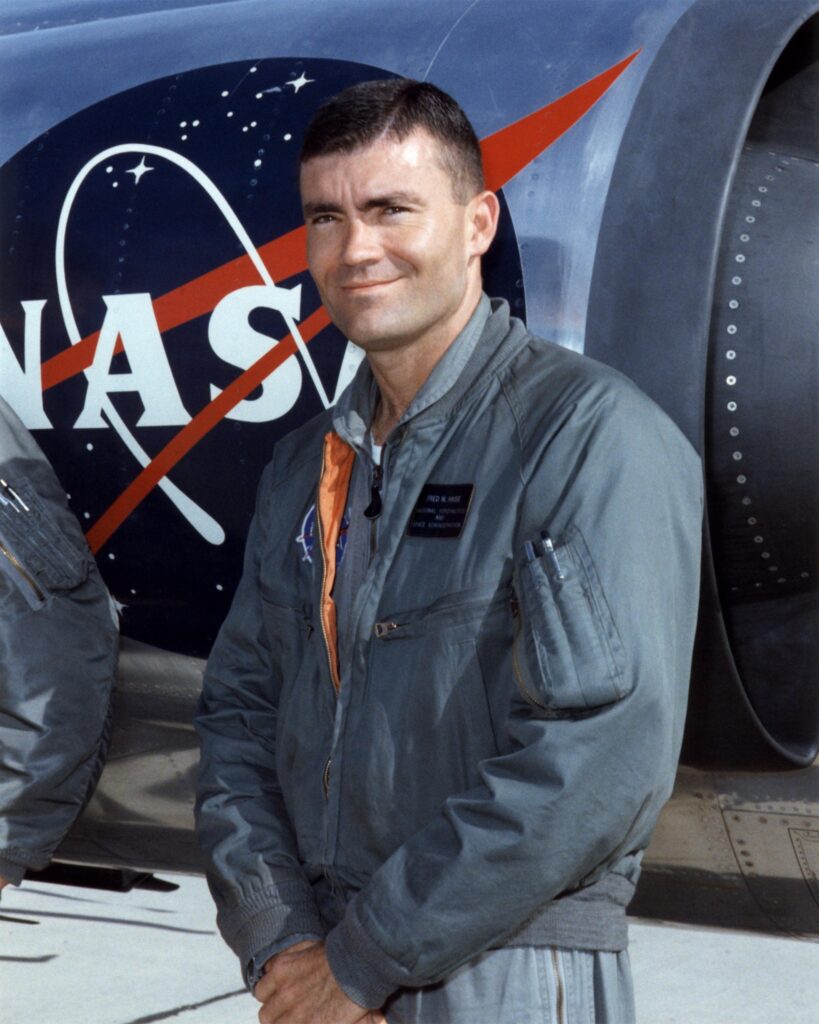Lunar Module pilot on Apollo 13 mission.
Fred W “Pecky” Haise, Jr. was born in Biloxi, Mississippi, on November 14, 1933. He graduated from Biloxi High School then attended Perkinston Junior College, earning an Association of Arts. He received a Bachelor of Science degree with honors in Aeronautical Engineering from the University of Oklahoma in 1959 and received an honorary Doctorate of Science from Western Michigan University, awarded in 1970.
Haise began his military career in October 1952 as a Naval Aviation Cadet at Pensacola Naval Air Station, Florida before serving as a Tactics and All-Weather Flight Instructor in the Navy’s Advanced Training Command at Kingsville Naval Air Station, Texas.
From 1954 to 1956, Fred Haise was a Marine Corps Fighter Pilot at Cherry Point Marine Corps Air Station, North Carolina. From 1957 to 1959, he was a Fighter Interceptor Pilot with the 185th Fighter Interceptor Squadron in the Oklahoma Air National Guard, while a student at the University of Oklahoma. He was the Aerospace Research Pilot School’s outstanding graduate of Class 64A and served with the U.S. Air Force from October 1961 to August 1962 as a tactical fighter pilot and as chief of the 164th Standardization-Evaluation Flight of the 164th Tactical Fighter Squadron at Mansfield, Ohio.
In addition to his military duties, from September 1959 to March 1963, Fred Haise was a research pilot at NASA’s Lewis (now Glenn) Research Center in Cleveland, Ohio. During this time he authored several published papers, including “An Evaluation of the Flying Qualities of 7 General-Aviation Aircraft,” “Use of Aircraft for Zero Gravity Environment, May 1966,” and “An Evaluation of General-Aviation Aircraft Flying Qualities, March 30-April 1, 1966.”
After completing his degree, from 1963 to 1966, Haise was a civilian research pilot at the NASA Flight Research Center at Edwards Air Force Base, California, while continuing his flight training. He transferred to Houston and the Manned Space Center upon being selected as an astronaut in April 1966. Haise has logged over 9,300 hours flying time, including 6,200 hours in jets.
Captain Haise served as backup Lunar Module pilot for the Apollo 8 and 11, and in 1972 was backup Spacecraft Commander for the Apollo 16 mission. His only spaceflight was as the Lunar Module pilot on Apollo 13, launched from Kennedy Space Center on April 11, 1970.
Apollo 13 was scheduled as a ten-day mission and was to be the first landing in the hilly, upland Fra Mauro region of the Moon. Approximately 55 hours into the flight, however, a failure of the service module cryogenic oxygen system occurred. Haise, James A. Lovell (Spacecraft Commander) and John L. Swigert (Command Module pilot), working closely with Houston ground controllers, converted their lunar module Aquarius into a “space lifeboat.” Their emergency activation and operation of lunar module systems conserved both electrical power and water in sufficient supply to assure their safety and survival while in space, and for the return to earth after a harrowing lunar orbit to gain the speed necessary to re-enter the Earth’s atmosphere. While passing over the far side of the Moon at an altitude of 158 miles from the lunar surface Apollo 13 was 248,655 miles from earth, a record-breaking distance that still stands for manned flight. The mission ended with a safe splashdown in the Pacific Ocean on April 17 after a flight of 142 hours and 54 minutes.
From April 1973 to January 1976, Captain Haise was the technical assistant to the Manager of the Space Shuttle Orbiter Project. He was also commander of one of the two two-man crews who piloted space shuttle approach and landing test (ALT) flights during the period of June through October 1977. This series of critical orbiter flight tests involved initially Boeing 747/orbiter captive-active flights, followed by an air-launched, un-powered glide, approach, and landing tests (free flights). There were three captive mated tests with the orbiter Enterprise carried atop the Boeing 747 carrier aircraft, allowing in-flight low-altitude and low-speed test and checkout of flight control systems and orbiter controls, and five free flights which permitted extensive evaluations of the orbiter’s subsonic flying qualities and performance characteristics during separation, up and away flight, flare, landing, and rollout–providing valuable real-time data duplicating the last few minutes of an operational shuttle mission.
Captain Haise has earned many awards, including the Presidential Medal for Freedom (1970); the NASA Distinguished Service Medal; the AIAA Haley Astronautics Award for 1971; the American Astronautical Society Flight Achievement Awards for 1970 and 1977; the City of New York Gold Medal in 1970; the City of Houston Medal for Valor in 1970; the Jeff Davis Award (1970); the Mississippi Distinguished Civilian Service Medal (1970); the American Defense Ribbon; the SETP’s Ray E. Tenhoff Award for 1966; the NASA Exceptional Service Medal (1978); the JSC Special Achievement Award (1978); the Soaring Society of America’s Certificate of Achievement Award (1978); the General Thomas D. White Space Trophy for 1977 (1978); the SETP’s Ivan C. Kincheloe Award (1978); and the Air Force Association’s David C. Schilling Award (1978).
Fred Haise resigned from NASA in June 1979 to become Vice-President of Space Programs at Grumman Aerospace Corporation. He was also President of Grumman Technical Services, Inc. located at Titusville, Florida, and of Northrop Worldwide Aircraft Services at Lawton, Oklahoma. He retired from business in 1996 and lives in Texas.

